
Greek Astronomy
Key points: How ancient Greece introduced an entirely new pattern of thought; the extent of the resulting progress (strengths and weaknesses)
 |
| Quotation from "Prometheus Unbound" by Aeschylos; Prometheus is the central figure, shown stealing fire from the gods to deliver it to mankind. Athena, behind him, taught him astronomy, mathematics, and other skills and he passed this knowledge to humans. Helios, the god representing the sun, tends to his job. art from US National Academy of Sciences, photo by G. Rieke. |
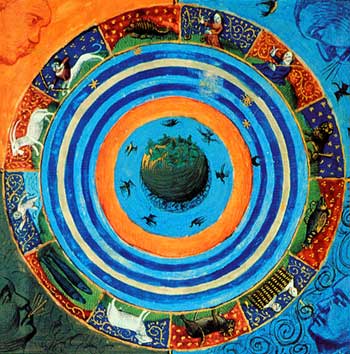 A representation of the Greek cosmology, with the earth at the center circled by the moon, sun, the planets, and the stars represented by the zodiac, from |
| http://www.aip.org/history/cosmology/ideas/larger-image-pages/pic-greekworldview-evanscover.htm |
 |
| Urania, the Greek muse of astronomy; Albani Collection, the Louvre. |
In most cases, the ancient astronomers studied only the motions of the planets with no thought to a physical underlying cause. Thus, the starting point for the Greek philosophers might be the cosmology represented to the right.
However, the ancient Greeks developed philosophical schools and universities that made them the center of learning in the classical world long after their city-states had lost their dominant military and economic power. They too made precise astronomical observations. For example, Hipparchus, who lived around 200 B.C., discovered that the location of the sun against the stars on the first day of spring is slowly moving eastward (this effect is called precession -- astrologers do not take precession into account so when they say that the sun is in Scorpius on a particular date, for example, the sun was in Scorpius 2000 years ago on that date!). In addition, they drew on the immense body of accurate observations and the mathematical techniques developed by the Babylonians, and refined and advanced them.
Most importantly, ancient Greece introduced the concept of physics, and
initiated scientific thought in general![]() The essence of their approach was to ask what could underly the things they observed in
nature, such as the motions of the planets
The essence of their approach was to ask what could underly the things they observed in
nature, such as the motions of the planets ![]() With regard to the motions of the planets, they were swayed
strongly by mathematical and philosophical arguments that demanded that
constant speed circular motion should be able to explain all the observations.
This belief was based purely on aesthetic arguments; although it had no
experimental backing, it had a strong influence on attempts to understand the
motions of the planets for nearly the next 2000 years!
With regard to the motions of the planets, they were swayed
strongly by mathematical and philosophical arguments that demanded that
constant speed circular motion should be able to explain all the observations.
This belief was based purely on aesthetic arguments; although it had no
experimental backing, it had a strong influence on attempts to understand the
motions of the planets for nearly the next 2000 years!
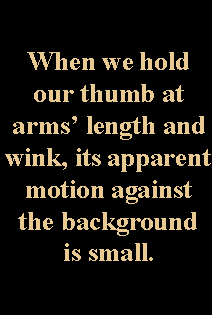 |
Applying scientific
reasoning made them expect to see parallax if the earth had been in motion -- they
recognized that this problem could be solved by putting the stars extremely far away, but
were reluctant to do so. We now know that the stars are very far
away, but there was no way for ancient astronomers to figure that out, and their
difficulty caused many centuries of wrong thinking. Parallax is the change in direction toward an object as our point of view changes. Here we compare judging the distance when we hold our thumb out and blink our eyes and to see the parallax against a distant scene with judging the distance to a star by observing it against more distant stars as the earth goes around its orbit. (From Jeremy Nelson http://ganesh.colorado.edu/nelson/ , modified by G. Rieke) |
Although they introduced
the possibility that the earth moved around the sun, rather than vice versa, the
Greeks did not adopt this picture.
![]()
Even for the Greeks science was still mixed up with aesthetics and philosophy. Thus, some of their other reasons to prefer that the sun revolved around the earth seem less scientific than the issue of parallax:
They felt that the earth was not part of the heavens because:
1. The celestial objects are bright points of light while the earth is an immense nonluminous sphere of mud and rock.
2. There is little change in the heavens: Stars are the same night after night. Earth is home of birth, change, and destruction. Celestial bodies have immutable regularity that is never to be achieved on the corruptible Earth.
3. Our senses show Earth is stationary.![]()
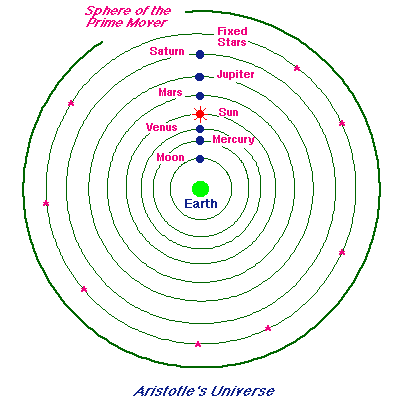 |
Aristotle (~ 350 B.C.) was a great biologist, but as a physicist and
astronomer was more of a synthesizer of other work. His writings became the basis for
medieval science and therefore were extremely influential for centuries. His nonmathematical approach to physics, devoid of abstract physical laws such as we will encounter with Newton, proved to be remarkably sterile in terms of scientific progress. To provide such a non-abstract picture of the planetary motions, Aristotle even proposed that they were carried on giant crystalline spheres that had to somehow be geared against each other to reproduce the observed motions. These motions included revolving around the earth every day (as things rose and set) as well as reproducing retrograde motion and the other details of the movements of the planets. (From U. Tenn, Ast. 161, http://csep10.phys.utk.edu/astr161/lect/retrograde/aristotle.html No one seemed to worry about how to get all that crystal, or how to keep the spheres moving. |
What was the major contribution of the ancient Greeks to astronomy![]()
Test your understanding before going on![]()
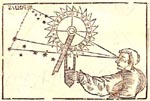
Observing with a "nocturnal," from http://www.math.nus.edu.sg/aslaksen/teaching/heavenly.shtml |
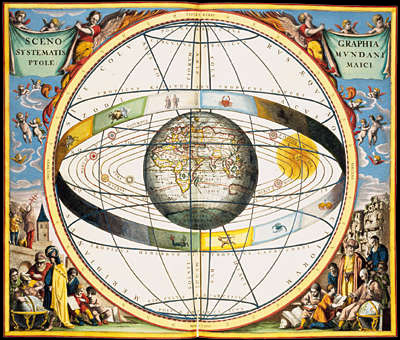
Ptolemy's model, with a central Earth orbited by planets and the sun, and with the stars on a more distant sphere. (from http://www.uscarom.org/billiard_ball_universe.html) |
|
Click to return to syllabus |
||
| Click to go to Ancient Astronomy | hypertext |
Click for Ptolemy |